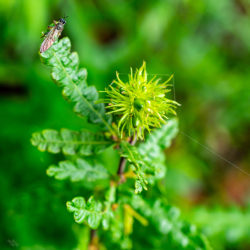Etymology
Comptonia is named in honor of the Rev. Henry Compton (1632-1713), bishop of Oxford, dendrologist and patron of botany; peregrina is Latin for one who travels.
Native Habitat
Dry, open woods and sandy barrens.
Garden Uses
Sweet-fern grows well in sandy soils, from well-drained dry sites to the edges of marshes. It is a good plant for stabilizing slopes or embankments and is a low-maintenance plant that tolerates drought. An interesting and vigorous plant for native plant gardens or naturalized areas where it can be left alone to colonize—be sure to give it plenty of room.
Overview
Sweet-fern is an upright, deciduous shrub (typically growing 2-4' tall and spreading 4’-8’). A native shrub of eastern North America that most often occurs in poor, sandy or gravelly soil; it is a good shrub for areas with poor soils, such as along alleys, waste areas or roads. The foliage is aromatic and resembles that of a fern, hence the common name of Sweet-fern. It fixes its own nitrogen.
Leaves and Stems
The leaves are simple, narrow, lustrous, pinnatifid (divided, but not all the way to the center), deeply notched, olive to dark green (to 4" long). Multiple stems with loose, spreading branches.
Flowers
The flowers are insignificant, yellowish green catkins that appear in spring before the leaves unfurl.
Fruit/Seed
The flowers give rise to a small greenish brown, burr-like nut enclosed in a bur-like husk.
Animal Associates
Sweet-fern attracts both birds and butterflies. It is a larval host plant for a wide variety of moths including the Io moth and several sphinx moth species. It is also a host plant for the Gray Hairstreak (Strymon melinus) butterfly.
Propagation
Root cuttings are the principal means of propagation.
Ethnobotanical Uses
An infusion of the leaves has been used by some native American tribes to treat poison ivy.
Garden Location
Teaching Garden (see garden map)
Sources
Lady Bird Johnson Wildflower Center
Plant Profile by Kathy Kling


